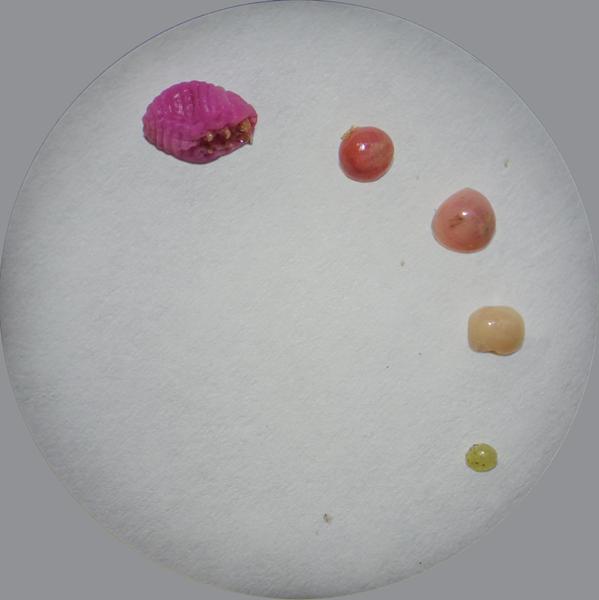Description
Ground pearls are scale insects belong to the family Margarodidae. Ground pearls appear as small, pearl-like formations on the roots or in the thatch, just below the soil surface. The adult female ground pearl is a wingless, pinkish scale insect, about 1⁄16 inch long with well-developed forelegs and claws (Figure 1). The male is a gnat-like insect smaller than the female, but with a slender waxy "tail" up to 1⁄4 inch long. Adults are typically active in late spring and early summer. Clusters of pinkish-white eggs are laid in a white waxy sac. The actual "pearl" shape is represented by the nymph which is covered with a hard, globular, yellowish-purple shell. Encysted nymphs are up to 1⁄16 inch in diameter (Figure 1).
Biology
Ground pearls are potentially serious problems in both southeastern and southwestern states. The roots of Bermuda-, St. Augustine-, zoysia-, and centipedegrasses are most commonly infested with ground pearls. Ground pearl nymphs extract juices from underground plant parts. Attack to the roots may cause circular dead areas that resemble fairy ring. The damage is most apparent during dry spells as irregular patches of grass turn yellow. The grass in these spots eventually turns brown and usually dies by fall. The spots enlarge each year and only weeds grow in the infested areas. Overwintering takes place in the pearl stage. Females usually mature in late spring and emerge from their cysts. After a brief period of mobility, females tunnel 2 to 3 inches into soil and secrete a waxy coat. Within this protective covering, females develop eggs (without mating) and deposit them throughout early summer. Approximately 100 eggs are laid by each female. The slender nymphs emerge in mid-summer and infest grass rootlets. Once they initiate feeding, nymphs soon develop the familiar globular appearance. There is usually one generation each year. However, if conditions are not favorable for emergence, female nymphs may remain in the pearl stage for several years.
Control
Cultural Control
When establishing new turf with sod or sprigs, check the roots to avoid planting infested grass. Watering, liming and fertilizing as prescribed by a soil test, proper mowing height with a sharp blade and other good cultural practices may help lawns recover from ground pearl injury, but such recovery may be temporary. Other warm season types of turf, such as bermudagrass, carpetgrass (Axonopus spp.) or bahiagrass, appear to be less sensitive to ground pearls and should be considered for lawns with severe ground pearl problems. Be sure to thoroughly clean equipment as it moves between sites to minimize the spread of ground pearls.
Chemical Control
Although some products containing the combination of bifenthrin + zeta-cypermethrin are labelled for ground pearl control, these active ingredients are not effective against a ground pearl infestation. Research at Clemson University evaluated insecticide applications for ground pearl control and found that three months post-treatment, no product had an impact on ground pearl populations. At nine months, products containing the active ingredients clothianidin (combined with a wetting agent) and thiamethoxam seemed to have some efficacy but do not provide "great" control. One thing to note is that broad-spectrum insecticides (particularly products like Sevin that have the active ingredient carbaryl) had higher numbers of cysts and likely have a negative impact on beneficial natural enemies (Chong, 2018). Ultimatley, maintaining a healthy, vigorous lawn in hopes of minimizing damage is the best current recommendation.
References
- Ground Pearls in Turf. Chong, J.-H. 2018. Golf Course Management. doi: https://www.gcmonline.com/course/environment/news/ground-pearls-turf
- Common name: ground pearls, scientific name: Margarodes spp. (Insecta: Hemiptera: Margarodidae). Camerino, A. 2015 (revised). Featured Creatures. Entomology & Nematology, FDACS/DPI, EDIS. Publication EENY-277
- Don't Give up on Ground Pearls. Brandenburg, R. 2009. Grounds Maintenance.
- Ground pearls: a generic revision of the Margarodidae sensu stricto (Hemiptera: Sternorrhyncha: Coccoidea). Foldi I. 2005. Annales de la Société Entomologique de France (n.s.), 41: 81-125.
- Pest Control for Professional Turfgrass Managers. Bowman, D. et al. 2017. NC State Extension Publication AG-408. 81 pp.
- Extension Plant Pathology Publications
- Horticultural Science Publications
- North Carolina Agricultural Chemicals Manual
For assistance with a specific problem, contact your local Cooperative Extension center.
Publication date: Oct. 25, 2017
Revised: Aug. 3, 2022
Recommendations for the use of agricultural chemicals are included in this publication as a convenience to the reader. The use of brand names and any mention or listing of commercial products or services in this publication does not imply endorsement by NC State University or N.C. A&T State University nor discrimination against similar products or services not mentioned. Individuals who use agricultural chemicals are responsible for ensuring that the intended use complies with current regulations and conforms to the product label. Be sure to obtain current information about usage regulations and examine a current product label before applying any chemical. For assistance, contact your local N.C. Cooperative Extension county center.
N.C. Cooperative Extension prohibits discrimination and harassment regardless of age, color, disability, family and marital status, gender identity, national origin, political beliefs, race, religion, sex (including pregnancy), sexual orientation and veteran status.

